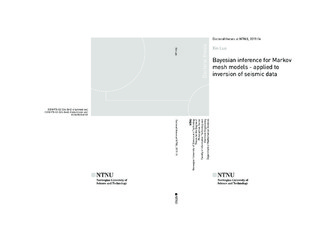| dc.contributor.advisor | Tjelmeland, Håkon | |
| dc.contributor.advisor | Omre, Henning | |
| dc.contributor.author | Luo, Xin | |
| dc.date.accessioned | 2019-02-18T10:33:56Z | |
| dc.date.available | 2019-02-18T10:33:56Z | |
| dc.date.issued | 2018 | |
| dc.identifier.isbn | 978-82-326-3643-3 | |
| dc.identifier.issn | 1503-8181 | |
| dc.identifier.uri | http://hdl.handle.net/11250/2585901 | |
| dc.description.abstract | To characterize a petroleum reservoir there are different types of data available, for example, seismic data and observations in wells. In this scenario, it is natural to adopt a Bayesian framework to incorporate observations with geological expertise and estimate reservoir properties. The likelihoods for the observations are quantified by the knowledge of natural sciences whilst the prior distribution is modeled based on geological expertise about the characteristics of the reservoir.
Seismic data are noisy and observations in wells are sparse, so it is essential to formulate a realistic prior distribution since the likelihood part will not dominate the properties of resulting posterior distribution.
The focus of the dissertation is on how to formulate a reasonable prior distribution for a spatially varying discrete variable, which may be used to model lithology/fluid classes in a petroleum reservoir. A spatial probabilistic model called Markov mesh model is chosen for the discrete variable.
Instead of manually specifying the parameters of the Markov mesh model, a generic parameterization is developed and a corresponding prior distribution is specified, so that stochastic simulation can be used to sample the parameters automatically based on a training image representation of the available general geological expertise. Thereby the model becomes adaptive to data without manual specifications. The dissertation also discusses how parallel computing can be used to improve the efficiency of the fitting process of the Markov mesh model.
Lastly, the dissertation demonstrates how the methodology can be used for prediction of lithology/fluid classes using seismic data. The advantage of using the Markov mesh model prior formulation is that it is more capable of representing the spatial connectivity patterns in the lithology/fluid classes. | nb_NO |
| dc.language.iso | eng | nb_NO |
| dc.publisher | NTNU | nb_NO |
| dc.relation.ispartofseries | Doctoral theses at NTNU;2019:16 | |
| dc.relation.haspart | Paper 1: Prior specification for binary Markov mesh models.
Statistics and Computing (2018)
Is not included in NTNU Open due to copyright available at
https://doi.org/10.1007/s11222-018-9813-7 | nb_NO |
| dc.relation.haspart | Paper 2: A multiple-try Metropolis–Hastings algorithm with tailored proposals
- This article is awaiting publication and is not included in NTNU Open | nb_NO |
| dc.relation.haspart | Paper 3: A Bayesian model for lithology/fluid class prediction using a Markov mesh prior fitted from a training image
-This article is awaiting publication and is not included in NTNU Open | nb_NO |
| dc.title | Bayesian inference for Markov mesh models – applied to inversion of seismic data | nb_NO |
| dc.type | Doctoral thesis | nb_NO |
| dc.subject.nsi | VDP::Mathematics and natural science: 400::Information and communication science: 420::Mathematical modeling and numerical methods: 427 | nb_NO |

